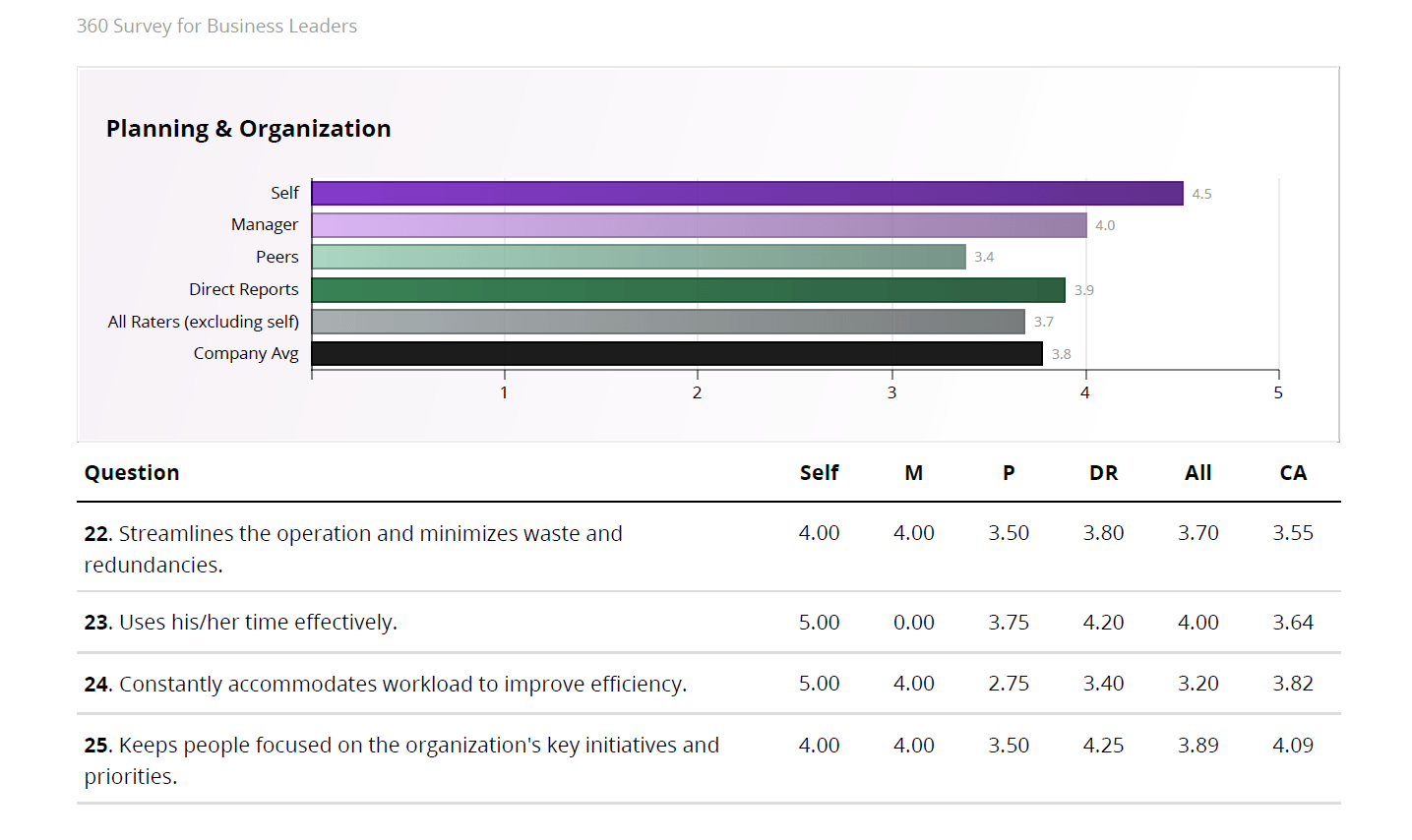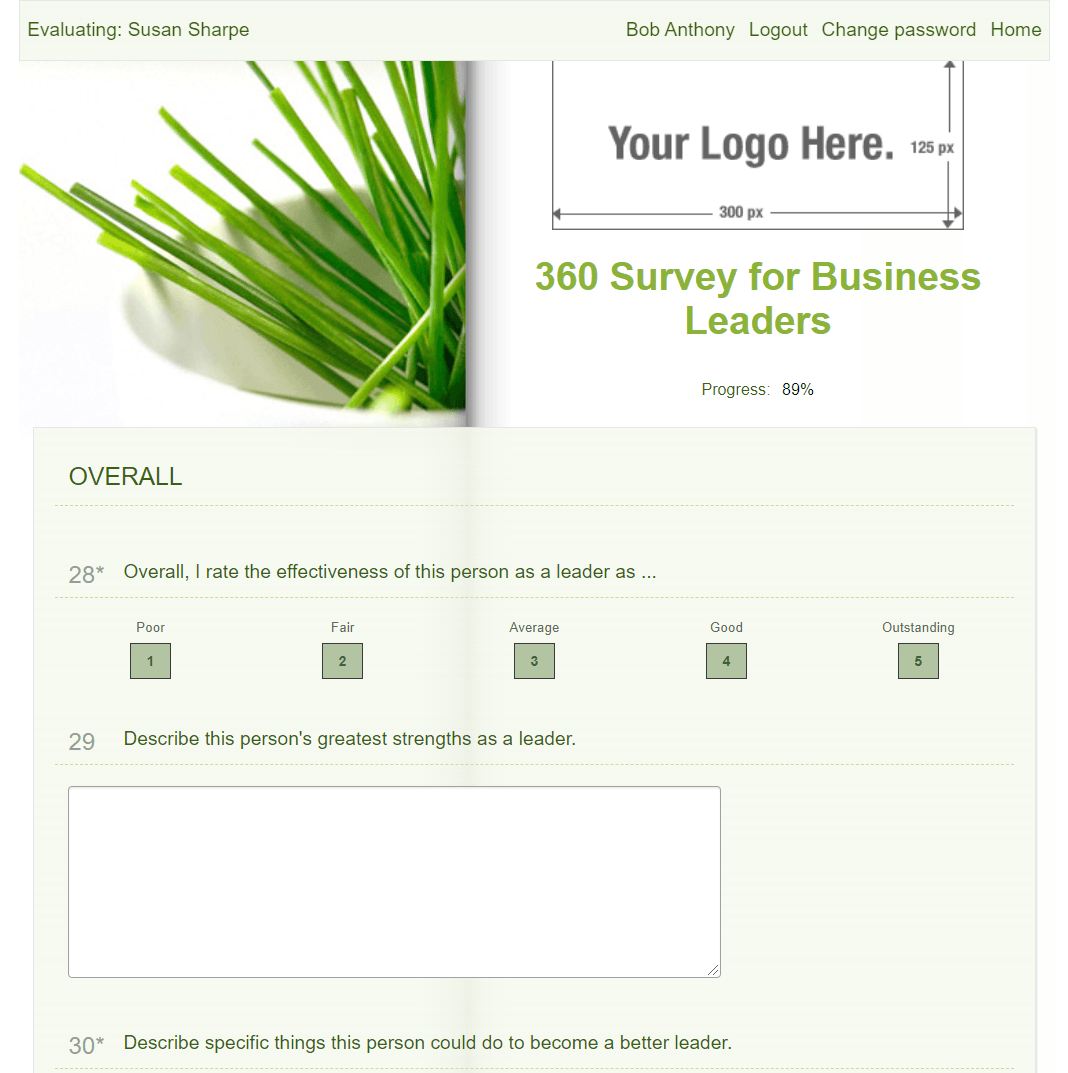DELVERING FEEDBACK
Individual Feedback
Schedule a time with every employee to provide personal feedback on their 360 employee evaluation and assessment report.
This is the time to review individual results, answer any questions the employee might have, and ease their concerns or fears. Insights should be discussed, strengths and untapped potential identified, and areas of weakness reviewed.
Remember, how you provide employee evaluation feedback can affect its effectiveness. An individualized development plan and/or training opportunity should be implemented to help the employee improve or develop skills that will benefit their growth and success.
Be sure to set expectations and inform employees that a follow-up will be conducted in 4-6 months to check-in and track their progress.
DEPARTMENT FEEDBACK
First, brief your department managers on results and insights gleaned from individuals within their team.
Then, schedule a time with each department to review evaluation and assessment outcomes. This is the time to accentuate positive performance results and identify any areas in need of improvements such as workflow, leadership, communication processes, and the delegation of duties.
This is an opportunity to unify teams, reveal untapped potential, encourage open discussion to find solutions that will boost productivity, and create an environment of mutual support and cooperation.
Keep in mind that each department is its own ecosystem and will each have their own takeaways from the assessment results and feedback.
PRESENT RESULTS TO EXECUTIVES
360 degree feedback benefits organizations because of 3 factors, namely, offering a new perspective, reducing the effects of biases, and reinforcing organizational goals. Following individual and department reviews and feedback, it is time to prepare a presentation of findings to company executives and the board of directors (if applicable).
This presentation should focus on overall 360-degree outcomes as they relate to business goals, including a review of the effectiveness of management, workflow effectiveness, department/workgroup strengths and areas of weakness, untapped potentials, identified needs, and training programs implemented to improve skills and growth.
Data on important business metrics should also be included to provide a point of reference for improvements. These key performance indicators will vary based on business types but can include workflow charts, customer service reviews, response times, cost per conversion/sale, etc.
DEVELOPMENT REPORT
8-12 months after the initial 360-degree employee evaluation and following the individual development follow-ups with each employee, it is time to brief departments and executives on progress including training and development plan successes, and their impact on business metrics previously identified as key performance indicators.
This completes the cycle of the 360 degree employee evaluation and is a time to reflect on results, benefits, and any pros and cons of the employee evaluation and assessment.
INTEGRATING YOUR COMPANY VALUES INTO 360 ASSESSMENT QUESTIONS
A way to reinforce the importance of your company’s values is by integrating them into employee assessments and evaluations.
Here is a definitive guide to making your 360 employee evaluation reflect the values that your company deems to be imperative.
COMMUNICATE COMPANY VALUES CLEARLY TO EMPLOYEES
If you are evaluating employees with your company values in mind, employees should first understand exactly what those values are. Company values may be communicated through employee onboarding packages, websites, newsletters, or the company intranet. When it’s time to conduct performance reviews with employee evaluation software, employees won’t be blindsided when you measure their performance against these values.
Another opportunity to clearly communicate company values is when an employee first joins the team.
As they already have to get oriented with a new environment and role, they can also learn what the company stands for. In turn, they can start to think how they can play their part in upholding the company’s mission.
PROVIDE FEEDBACK AND RECOGNITION MORE OFTEN
Employees appreciate feedback on their work and being recognized for their accomplishments. They feel happier and respected in the workplace—and companies that support and recognize employees benefit in increased productivity and reduced turnover.Feedback sessions don’t have to take a lot of time. It can be a casual catch-up to learn what the employee is working on and what they expect to achieve. During these conversations, let them know what you expect from them. When you outline your expectations, use the company values as a framework when it makes sense to. For employees who have shown their commitment to these values, publicly recognize and reward them through employee recognition programs.
ASK EMPLOYEES FOR THEIR FEEDBACK
Turn a performance review into an opportunity to have a conversation that benefits both parties. Many people dread performance reviews because they feel like it’s a one-sided discussion. Use a performance review as a chance to listen to your employees and ask them how they think your company can continue to evolve. It’s a great way to see if employees believe that your company truly embodies the values that it stands by.
Ask employees how well they think the company is demonstrating its core values. Do they feel supported by the managers and leadership to achieve these values? Are there any other ways they think the company can spearhead them? You’ll gain insight that could help you improve company culture and operations. It’s up to you to either ask these questions in your employee evaluation software or face-to-face.
STRUCTURE QUESTIONS RELATED TO VALUES-BASED WORK BEHAVIOURS
Employees should understand what behaviors they should be practicing to demonstrate values. For example, if creativity is part of a company core value, employees may be expected to demonstrate openness to learning and contributing new ideas at work. When creating employee performance review questions that are based on creativity, ask questions that flesh out the ways that employees demonstrated their commitment to being creative.
Before finalizing your questions, determine the most important values-based work behaviours of creativity:
- How active was the employee in generating new ideas and approaches?
- Was the employee willing to learn new methods and concepts?
- How did the employee adapt and overcome challenging situations?
In 360 assessments and evaluation, you’ll see how supervisors and colleagues rate an employee based on their relations and interactions at work. As they work directly with each other, they’re able to review just how well that employee demonstrates company values through their interaction with their colleagues. Use your employee evsluation software to customize questions that give you the insight you need.
BENEFITS OF HOLISTIC FEEDBACK
Feedback supplies useful insights into the behaviors and skills desired by the company to realize their goals, vision, mission, and values. Implemented with proper training and care to enable persons to build up careers, 360 degree feedback employee evaluation software is a constructive addition to employee performance management systems.
A benefit of 360 degree feedback employee evaluation software is that it provides multiple perspectives, which means that the employee gets a well rounded assessment of their overall performance. Through this system, the workers understand how their settlements affect others directly.
Further, the employers can conduct surveys or ‘one on one’ meetings with that input. The evaluators can be both external and internal. Ask customers to render circumstances in which the expectations were exceeded, met or not met.
ANONYMITY
Subordinates can render responses regarding managers devoid of the fears of reprisal. Never disclose names of the subordinates supplying feedback. When the same response is from more than one source, the workers do not feel they are being targeted by an individual.
Above all, the purpose of feedback systems is to help people understand their weaknesses and strengths, and give useful insights into certain aspects of their work, requiring professional development.




